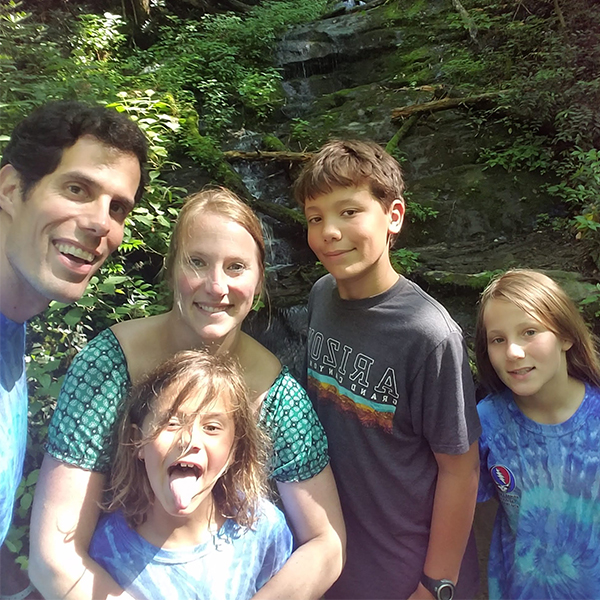 The Klaus family believes there is no better way to learn than by doing. This model of thinking is what led David and Melynne Klaus to establish a fund with the Central Indiana Community Foundation (CICF) for their three young children to advise.
The Klaus family believes there is no better way to learn than by doing. This model of thinking is what led David and Melynne Klaus to establish a fund with the Central Indiana Community Foundation (CICF) for their three young children to advise.
“In fact, we even debated calling it the Klaus Kids Fund but knew that it would be there for a long time when they grow up, so, when they are older maybe they wouldn’t want the kids,” Melynne said. “It was something that we thought could be a really great way of introducing them to giving.”
David and Melynne established the Klaus Family Fund in 2016 and immediately handed the grant-making reigns to their kids—Carter, 11, Elise, 8, and Kendall, 7. Although CICF works with many multi-generation fundholders and families that give together, it is unique for children as young as the Klaus children to have such a leading role in the process.
“Sometimes it’s good to talk about how you give and where you give, but we also wanted them to have ownership of the giving and find out what they were interested in without being influenced by us,” Melynne said. “We really let them take the lead…sometimes I think it’s hard for children to come up with their own interests without being influenced by their parents, so we sort of wanted to give them this platform.”
Melynne and David took themselves completely out of the decision-making process.
“I was pretty surprised when my mom and dad told me that they were letting us choose what to do instead of just choosing themselves.”
“Usually when we leave the room, they’re going to listen to others in authority there,” David said. “That’s how we chose CICF. At the end of the day, I didn’t feel like I had the strengths and abilities to help educate them on other partners out there that you could donate to. So, knowing the values that were there, I just had a lot of trust that CICF could do this process much more effectively than we could ever do it ourselves.”
And the kids’ reaction? “I was pretty surprised when my mom and dad told me that they were letting us choose what to do instead of just choosing themselves,” Carter said.
The children remember being a little unsure about what it would be like to award a grant, but those feelings didn’t last long. The family worked closely with a CICF philanthropic advisor and a special consultant from Indiana Philanthropy Alliance. After a variety of fun, engaging and thought-provoking activities, the children were able to identify their unique interests as well as some organizations they might be passionate about.
On a summer evening, while enjoying her ice cream, Elise explained that a superhero activity was her favorite because it highlighted the activities they enjoy.
“So, we made a superhero,” Elise said. “We colored a superhero. We have different things that we like to do. Carter likes to do homework, Kendal likes to do art, and I like to do reading. And, so, Carter wrote down Homework Man. Then I wrote down Reading Girl. I don’t know about Kendall.”
Between bites of her own ice cream, Kendall added that her superhero was Art Girl.
After creating their superheroes, the kids were asked about some of the world’s problems they wanted to solve.
Melynne explained that the kids started out by talking through things they like, and then they talked through things that they did not like as much.
“And it was really fascinating to see that list that they generated,” Melynne said. “Then the next part was when they kind of ranked their interests. They said let’s really focus on those and then they talked about different organizations.”
From that list of interests and organizations, they were able to narrow their choices down to School on Wheels and Paws to Read, a program through Paws & Think. After going on a site visit to both organizations, Elise chose School on Wheels, Kendall chose Paws to Read, and Carter decided to give to both organizations.
“I picked School on Wheels because it was really painful seeing children—see them not having homes they could actually live in,” Elise said. “School on Wheels works with children that don’t have a home or they had a fire in the home.” She added that the program provides children a structured space to do their homework after school.
Kendall was drawn to Paws to Read because of her love for animals. This is an organization that allows children to practice their reading skills by reading storybooks to the non-judgmental ears of therapy dogs. And Carter’s heart was equally drawn to both organizations.
“Well, I wasn’t sure which one [to choose] because we had visited both of them. It was hard because I really like dogs and reading, but I also thought about all the kids that didn’t have homes and school. I wasn’t sure, so I decided to split.”
“I think one thing that appealed to us was that CICF’s reach into the community is so broad.”
The entire decision process gave the Klaus children hands on experience with philanthropy, while learning about different not-for-profit organizations in their community.
“I think one thing that appealed to us was that CICF’s reach into the community is so broad,” Melynne said. “And so, knowing about and supporting through the variety of giving channels that CICF manages, just the sheer number and scope of organizations that CICF works with is something that was really helpful for us, so that as the kids explore there’s a lot of knowledge to draw upon at the community foundation and that, to us, was a real positive thing.”
“I didn’t really know about School On Wheels,” Carter said. “I thought School on Wheels was just like this tutoring system, that [kids] were just tutored. I didn’t know those people didn’t have homes. I just didn’t know what it was.”
Melynne was not surprised by the organizations the kids chose to give to. She said their choices reflect the things that they care about in their own lives. The exciting part for her was seeing that they came up with more than one cause that they were interested in.
All three children agree that other kids should have the opportunity to give. After sharing the story of their family giving, some of their friends have become interested in giving, too. Although there are giving opportunities through their schools, they are not as specific to the kids’ interests.
“They have some opportunities to contribute to some drives through school where they have collections of material things and then they also collect box tops,” Melynne said. “So, they definitely do get some education about giving, but very rarely do they get to do the site visit and conversation about their interests and alignment.”
As the kids start preparing for their next round of giving, all three are feeling more prepared than they did the first time around.
“I didn’t really get what we were doing the first time,” Carter said. “I just knew we were able to give some money away to an organization, but I didn’t really get anything else about it. And after I [learned] way more about it…. I get why we’re doing this.”
“I felt scared, and I felt like it would be a really hard thing, but instead, all the people that helped me, it made it easier to give out,” Elise said. “I learned that giving will sometimes help other people…. It felt good to me because I was actually helping real people.”
This whole process has helped spark more family conversations about the importance of giving and different ways to become involved in helping their community.
“The best way to learn is by doing, and so giving back to the community was really important to us and we hope that it is something that will become really important to Carter, Elise and Kendal,” Melynne said. “What’s the best way of learning? It’s by experiencing it.”
If you would like to learn more about including your children in your family’s philanthropy, no matter their age, CICF philanthropic advisors can help. For more information, call 317.634.2423.






this page is all about me and my family!!!!!